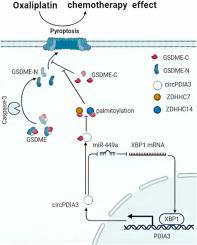当前位置:
X-MOL 学术
›
Drug Resist. Updat.
›
论文详情
Our official English website, www.x-mol.net, welcomes your
feedback! (Note: you will need to create a separate account there.)
CircPDIA3/miR-449a/XBP1 feedback loop curbs pyroptosis by inhibiting palmitoylation of the GSDME-C domain to induce chemoresistance of colorectal cancer
Drug Resistance Updates ( IF 15.8 ) Pub Date : 2024-05-28 , DOI: 10.1016/j.drup.2024.101097 Jiatong Lin 1 , Zejian Lyu 2 , Huolun Feng 1 , Huajie Xie 2 , Jingwen Peng 3 , Weifu Zhang 4 , Jun Zheng 5 , Jiabin Zheng 2 , Zihao Pan 2 , Yong Li 1
Drug Resistance Updates ( IF 15.8 ) Pub Date : 2024-05-28 , DOI: 10.1016/j.drup.2024.101097 Jiatong Lin 1 , Zejian Lyu 2 , Huolun Feng 1 , Huajie Xie 2 , Jingwen Peng 3 , Weifu Zhang 4 , Jun Zheng 5 , Jiabin Zheng 2 , Zihao Pan 2 , Yong Li 1
Affiliation

|
Although oxaliplatin (OXA) is widely used in the frontline treatment of colorectal cancer (CRC), CRC recurrence is commonly observed due to OXA resistance. OXA resistance is associated with a number of factors, including abnormal regulation of pyroptosis. It is therefore important to elucidate the abnormal regulatory mechanism underlying pyroptosis. Here, we identified that the circular RNA circPDIA3 played an important role in chemoresistance in CRC. CircPDIA3 could induce chemoresistance in CRC by inhibiting pyroptosis both and . Mechanistically, RIP, RNA pull-down and co-IP assays revealed that circPDIA3 directly bonded to the GSDME-C domain, subsequently enhanced the autoinhibitory effect of the GSDME-C domain through blocking the GSDME-C domain palmitoylation by ZDHHC3 and ZDHHC17, thereby restraining pyroptosis. Additionally, it was found that the circPDIA3/miR-449a/XBP1 positive feedback loop increased the expression of circPDIA3 to induce chemoresistance. Furthermore, our clinical data and patient-derived tumor xenograft (PDX) models supported the positive association of circPDIA3 with development of chemoresistance in CRC patients. Taken together, our findings demonstrated that circPDIA3 could promote chemoresistance by amplifying the autoinhibitory effect of the GSDME-C domain through inhibition of the GSDME-C domain palmitoylation in CRC. This study provides novel insights into the mechanism of circRNA in regulating pyroptosis and providing a potential therapeutic target for reversing chemoresistance of CRC.
中文翻译:

CircPDIA3/miR-449a/XBP1反馈环通过抑制GSDME-C结构域的棕榈酰化来抑制细胞焦亡,从而诱导结直肠癌的化疗耐药
尽管奥沙利铂(OXA)广泛用于结直肠癌(CRC)的一线治疗,但由于 OXA 耐药,结直肠癌复发的情况很常见。 OXA 抗性与多种因素相关,包括细胞焦亡的异常调节。因此,阐明细胞焦亡背后的异常调节机制非常重要。在这里,我们发现环状 RNA circPDIA3 在 CRC 化疗耐药中发挥重要作用。 CircPDIA3 可以通过抑制焦亡来诱导 CRC 化疗耐药。从机制上讲,RIP、RNA pull-down 和 co-IP 分析表明,circPDIA3 直接与 GSDME-C 结构域结合,随后通过 ZDHHC3 和 ZDHHC17 阻断 GSDME-C 结构域棕榈酰化来增强 GSDME-C 结构域的自身抑制作用,从而抑制细胞焦亡。此外,还发现circPDIA3/miR-449a/XBP1正反馈环路增加了circPDIA3的表达以诱导化疗耐药。此外,我们的临床数据和患者来源的肿瘤异种移植(PDX)模型支持 circPDIA3 与 CRC 患者化疗耐药性的发展呈正相关。综上所述,我们的研究结果表明,circPDIA3 可以通过抑制 CRC 中的 GSDME-C 结构域棕榈酰化来放大 GSDME-C 结构域的自身抑制作用,从而促进化疗耐药。这项研究为circRNA调节细胞焦亡的机制提供了新的见解,并为逆转CRC化疗耐药性提供了潜在的治疗靶点。
更新日期:2024-05-28
中文翻译:

CircPDIA3/miR-449a/XBP1反馈环通过抑制GSDME-C结构域的棕榈酰化来抑制细胞焦亡,从而诱导结直肠癌的化疗耐药
尽管奥沙利铂(OXA)广泛用于结直肠癌(CRC)的一线治疗,但由于 OXA 耐药,结直肠癌复发的情况很常见。 OXA 抗性与多种因素相关,包括细胞焦亡的异常调节。因此,阐明细胞焦亡背后的异常调节机制非常重要。在这里,我们发现环状 RNA circPDIA3 在 CRC 化疗耐药中发挥重要作用。 CircPDIA3 可以通过抑制焦亡来诱导 CRC 化疗耐药。从机制上讲,RIP、RNA pull-down 和 co-IP 分析表明,circPDIA3 直接与 GSDME-C 结构域结合,随后通过 ZDHHC3 和 ZDHHC17 阻断 GSDME-C 结构域棕榈酰化来增强 GSDME-C 结构域的自身抑制作用,从而抑制细胞焦亡。此外,还发现circPDIA3/miR-449a/XBP1正反馈环路增加了circPDIA3的表达以诱导化疗耐药。此外,我们的临床数据和患者来源的肿瘤异种移植(PDX)模型支持 circPDIA3 与 CRC 患者化疗耐药性的发展呈正相关。综上所述,我们的研究结果表明,circPDIA3 可以通过抑制 CRC 中的 GSDME-C 结构域棕榈酰化来放大 GSDME-C 结构域的自身抑制作用,从而促进化疗耐药。这项研究为circRNA调节细胞焦亡的机制提供了新的见解,并为逆转CRC化疗耐药性提供了潜在的治疗靶点。































 京公网安备 11010802027423号
京公网安备 11010802027423号